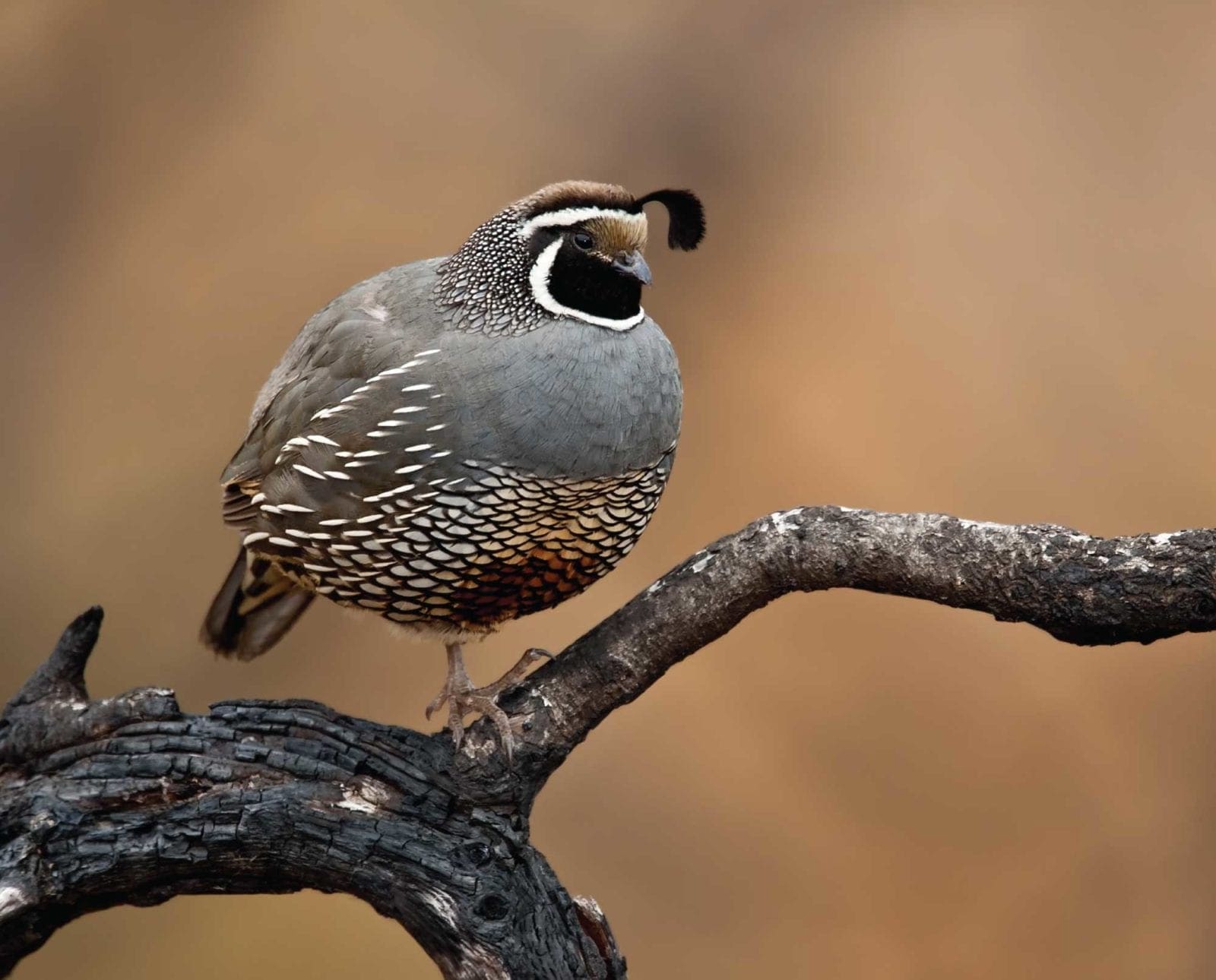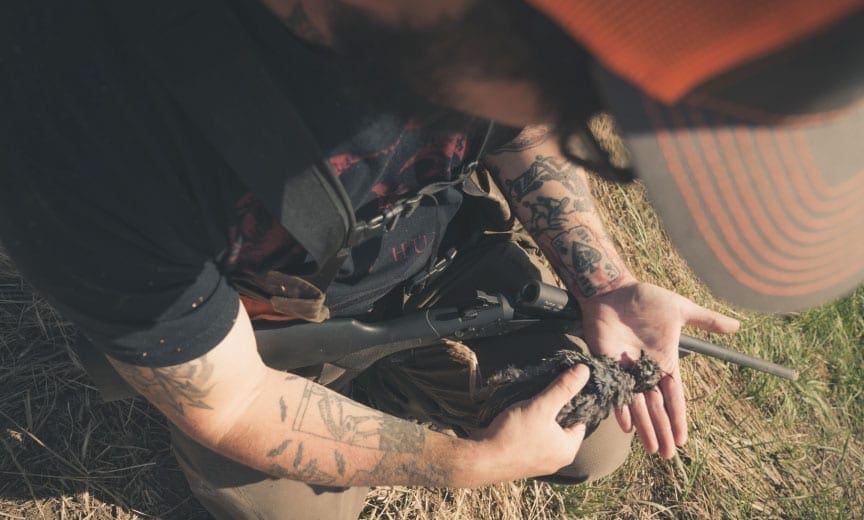Home » Quail Species » California Quail Hunting » California Quail (Callipepla californica) – The Valley Quail Life History
California Quail (Callipepla californica) – The Valley Quail Life History
- Climate Change Impact (Audubon) | +1.5°C - 23% Range Lost | +3.0°C - 43% Range Lost

Ryan Lisson is a biologist and regular content contributor to…
The life history and hunting opportunities of the California Quail also known as the Valley Quail
The California quail (Callipepla californica) primarily occupies the West Coast, from British Columbia down to Mexico. It is the most popular species of quail on the West Coast and prefers semi-open habitats at lower elevations. It avoids mountains, which is probably why it’s also known as the valley quail. Although it closely resembles the Gambel’s quail, there are a few key differences between these two species. However, their familiar arching crest is what many people imagine when they think of quail, popularized in the movie “Bambi” from years ago (All About Birds 2018).
Description and Life History of the California Quail
As mentioned, the California quail is similar to the Gambel’s quail in general coloration and appearance, but is a slightly larger, plumper bird. It has a round body, short tail, short legs, and a small head. Males and females look fairly different. Females are very well camouflaged with brownish-gray feathers around their head, neck, and upper breast, while their undersides are tan/cream colored and scaly-looking (All About Birds 2018). They have a short dark brown crest on top of their head. Males have similar gray colored neck and breast feathers and brown and white wings, but their heads really stand out with a black face, white outlines and a mahogany brown top. Their crest is full, comma-shaped, black and arches forward above their face. Their underside/belly also stands out prominently from the front – it is very scaly-looking, creamy yellow and has a cinnamon/chestnut patch in the center (All About Birds 2018). The scaly appearance and coloration of their bellies can be used to identify California quail from Gambel’s quail, although they do not generally overlap in range.
As the breeding season kicks off – January in southern states or May in northern states – males will call loudly to attract a female and announce its territory (NatureServe 2018; All About Birds 2018). A male will also display for females by spreading its wings and tail fan, bobbing its head and rushing at the female (All About Birds 2018). After breeding, females will commonly build their nests on the ground adjacent to thick cover or under a log, but they may also build nests in tree branches or use another bird’s old nest. Ground nests are made by scratching out a small depression and lining it with grass and leaves (National Audubon Society 2018). Females often lay 10 to 17 buff speckled eggs, which she incubates alone for about 18 to 23 days (NatureServe 2018; National Audubon Society 2018). After hatching, both parents guide and tend the chicks, but the chicks feed by pecking at the ground immediately. Females usually have one brood per season, but may raise another in years with good food supply (National Audubon Society 2018).
California quail form spectacular coveys of up to 200 birds in the fall and winter, but break up for breeding and nesting in the late winter or early spring of the following year (NatureServe 2018). They roost in trees during the night, feed mostly in the morning and evening and spend their days resting and hiding from predators in thick cover (All About Birds 2018). Although California quail occasionally feed in trees, they mostly feed on the ground. They are primarily seed eaters (e.g., clover, lupine, grasses, grains), but also forage on leaves, small acorns, berries (e.g., manzanita, poison oak, etc.), catkins, and shoots (NatureServe 2018; All About Birds 2018; National Audubon Society 2018). They will opportunistically feed on insects and other invertebrates (e.g., caterpillars, beetles, ants, grasshoppers, millipedes, mites, spiders and snails) as well (All About Birds 2018).
The California quail uses its social tendencies to avoid predators throughout the fall and winter. Large coveys of quail will often post male lookouts or sentinels at an elevated spot (such as a tree branch or fence post) to watch for predators while the others feed or rest (All About Birds 2018). During the breeding season, the California quail relies on its excellent camouflage to avoid being detected. Predators of eggs, chicks, and adults alike include hawks, owls, snakes, and coyotes (NatureServe 2018).
Range and Habitat of the California Quail
The California quail is a common year-round resident along the West Coast, including California, Nevada, Oregon, Washington, and Idaho, but it also occurs in British Columbia and Mexico (National Audubon Society 2018). As mentioned above, the California quail is generally isolated from Gambel’s quail and mountain quail, but they do overlap in some parts of California. For example, you could find mountain quail and California quail relatively close to one another midway up a slope.
The California quail is a very adaptable upland game bird. High desert oak woodlands, chaparral, pinyon-juniper woodlands, coastal sage scrublands, grasslands, farm fields, and back yards all offer the right mix of habitat types (NatureServe 2018; All About Birds 2018; National Audubon Society 2018). At lower elevations, you’ll commonly find them near water features, such as riparian stream banks, where briars and cottonwoods are the dominant vegetation. At higher elevations, they occupy oak savannas and chaparral.
Conservation Issues for the California Quail
The California quail is generally secure across its range (NatureServe 2018). The global breeding population of California quail is estimated to be about 3.8 million birds, with about 71 percent occurring in the United States, three percent in Canada, and 11 percent in Mexico (All About Birds 2018). Similar to the bobwhite quail, California quail are also threatened by habitat loss due to cattle grazing and urbanization. At the same time, they are proving to be adaptable to development and are often observed at backyard bird feeders (National Audubon Society 2018). Although hunters take between 800,000 and 1.2 million birds each season in California alone, it seems they are resilient to the hunting pressure (All About Birds 2018). Another threat includes the severity and frequency of wildfires, which seems to escalate more every year. When paired with drought conditions, California quail habitat can rapidly be destroyed, which inevitably produces a decline in the quail population.
Hunting Opportunities for the California Quail
You can pursue the California quail in a few western states, but as per its name, California is definitely its stronghold and the most popular place to hunt them. Hunting upland birds in California is exciting and offers a bit of a mixed bag, with the opportunity to shoot a “California Slam” on California, Gambel’s, and mountain quail. You can usually hunt mountain quail up higher in elevation, and head down to the valleys to hunt California quail and even some Gambel’s quail. Here are a few states where you can hunt them, as well as their season dates and possession limits. Note that many states have different zones with different season dates, so study where you will be hunting to know the actual legal season.
| State | Season | Season/Possession Limit |
| Arizona | October 18-February 09, 2020 | 15/45 |
| California | September 28-January 26, 2020* | 10/30 |
| Idaho | September 19-January 31, 2021 | 10/30 |
| Nevada | October 12-February 2, 2020 | 10/30 |
| Oregon | September 1-January 31, 2020 | 10/30 |
| Utah | November 2-December 31, 2019 | 5/15 |
| Washington | September 28-January 20, 2020* | 10/30 |
*Maximum season – different zones have different dates
These dates are subject to change. Always check with local game laws for the most up-to-date laws before hunting.
California quail typically stay below elevations of 5,000 feet. The early successional, broken shrub and young forest patchwork that follows wildfires is a great place to start, especially if there are water features flowing through it. Because they are most active in the mornings and evenings, these are the prime times to be hunting.
Having a bird dog with you can be a game changer. California quail are known to flush well out ahead of you and then individual birds will often hold tight until you pass and flush behind you. A good bird dog should be able to get their nose on them and help you find the lone birds or small groups that hold tight. These birds aren’t very big, so a 20 gauge shotgun with an improved cylinder or modified choke will work just fine.
If you have a chance to chase these birds, do it. In prime habitat conditions when the rains have produced an abundance of greenery, water, and insects, the quail hunting can be unforgettable.
Sources:
All About Birds. 2018. California Quail. Accessed at: https://www.allaboutbirds.org/guide/California_Quail/lifehistory
National Audubon Society. 2018. Guide to North American Birds. Accessed at: https://www.audubon.org/field-guide/bird/california-quail
NatureServe. 2018. NatureServe Explorer: An online encyclopedia of life. Accessed at http://explorer.natureserve.org
Ryan Lisson is a biologist and regular content contributor to several outdoor manufacturers, hunting shows, publications, and blogs. He is an avid small game, turkey, and whitetail hunter from northern Minnesota and loves managing habitat almost as much as hunting. Ryan is also passionate about helping other adults experience the outdoors for their first time, which spurred him to launch Zero to Hunt, a website devoted to mentoring new hunters.




